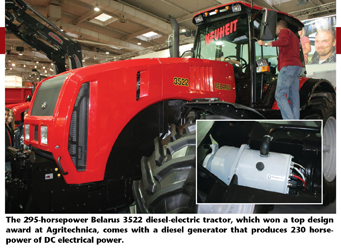
The automotive industry generated a lot of sizzle with the introduction of hybrid vehicles.
Fuel savings can be substantial with such powertrains, but these savings by themselves can take a long time to pay for the additional hybrid vehicle technologies.
The principal advantage of hybrid motor vehicles is that they need no extra infrastructure. Their engines run on regular motor fuels, and they operate like trucks and buses, except more economically and while producing fewer emissions.
Will hybrid engines ever be cost-effective for agricultural applications?
The most likely hybrid technology candidate for agriculture is a diesel-electric (DE) system. These are simply diesel engines connected to a generator, which create electricity to power components including propulsion motors and ancillary systems. While such principals may sound futuristic, they have been used successfully on locomotive engines since 1895 following the development of a prototype engine developed by General Electric. Other long-term applications of diesel-electric systems include ships, submarines, large LeTourneau loading open-pit mining shovels, snow groomers and New York City busses.
Manufacturers of farm and construction equipment are taking a long, hard look at hybrid diesel-electric engines. Some of the most recent include the following applications.
Caterpillar D7E DE Hybrid Bulldozer. In this case, the manufacturer claims a 10% increase in productivity, coupled to a 10-30% reduction in fuel consumption. However, customers using early production machines are reporting even better results in fuel use. In lower load applications, they’ve observed 40-50% reductions in fuel use.
Peterbilt Model 335 DE Dump Truck. In this application, an electric motor is mounted in the driveline, ahead of a 6-speed mechanical transmission. During braking, the motor becomes a generator that produces electricity, which the system stores in a bank of lithium-ion batteries. The more the truck stops and starts the greater the fuel savings and the lower the emissions.
John Deere 7030 E-Premium Tractors. These European tractors were released 2 years ago and incorporate a crankshaft driven 27-horsepower electric generator. This creates either a 230V single-phase or 400V three-phase systems to provide power in lower demand applications, such as the discs on a Kuhn fertilizer spreader, external lights or hand tools.
Belarus DE Tractor. It’s not often that the winner of a design and engineering award comes from Russia, but at the Agritechnica show in November, it came in the form of a Belarus tractor. The Belarussian tractor maker showed a 295-horsepower diesel-electric tractor that generates an amazing 230-horsepower of DC electricity. That power is used to run the PTO, fertilizer spreaders, sprayers and anything else that is able to utilize electric power.
Benefits of DE Systems
Diesel-electric power systems offer several benefits over conventional mechanical systems. These include the following:.
Improved Efficiency. With the new DE systems, electric generator output is matched to a consistent and fuel-efficient engine speed. From an agricultural perspective, tractor manufacturers suggest that a smaller tractor, such as a 125-horsepower unit, may only use full engine power 20-25% of the time. Surprisingly, the same tractor operates at minimum load (including idling) 30-40% of the time. So, if a smaller engine was installed within such a platform and coupled to a generator, additional power could be drawn from a rechargeable battery during high-load operations. The battery could then be recharged during low-load operations.
During idling, the diesel engine would be shut down and auxiliary systems, including air-conditioning, lights, radio etc., would be powered from the battery system. This not only reduces fuel consumption, but also lowers emissions and extends engine life. (Most electric motors have a 30,000-50,000 hour service life.) Such a system would also eliminate the need for conventional batteries and starter motor, as the engine would be kick-started by the main electric motor.
No Clutch Needed. Only electric motors can supply full torque from zero RPM. Compared to a conventional transmission, which needs to be revved up to reach the required torque curve, this is far more efficient and eliminates the clutch and its associated costs.
Challenges of DE Systems
Like all new technologies, there will a hefty price tag on early diesel-electric entries to the market. There will also be a steep learning curve when it comes to training service technicians. Dealer personnel will need in-depth training to service and repair high-voltage electrical systems. Special tools and diagnostic equipment will also be required for service work.
Other concerns surround the safety and durability of electrically powered equipment, especially as these systems are operated in rain, mud, dust and heat.
Implements and other equipment to which the diesel-electric systems can be coupled will be needed. One final challenge is the life and size of battery packs, especially when the platform needs to draw 50-100 horsepower, for example.
The Future of DE Systems
Interest in hybrid vehicles for agriculture is increasing and you can be sure that some type of diesel-electric tractors will be running on farms in the next few years. AGCO just introduced a new electric prototype sprayer at the Ag Connect Expo in January
Personally, I believe some of the most suitable platforms for diesel-electric technology will include equipment such as combines. Imagine replacing the belts and chain drives with electric motors. Not only would this reduce the number of moving parts, but also the wear on components as well as damage to grain.
Such applications might include an electrically powered cutter-bar or clean grain elevator. When running at slow speeds or with low grain-flow, these components would operate at a slower speed. As the combine speeds up, the components would pick up proportionate speed. Items like unloading augers could also be powered with electric motors to provide a steady increase in speed, compared to sudden shock-starts on existing systems.






Post a comment
Report Abusive Comment